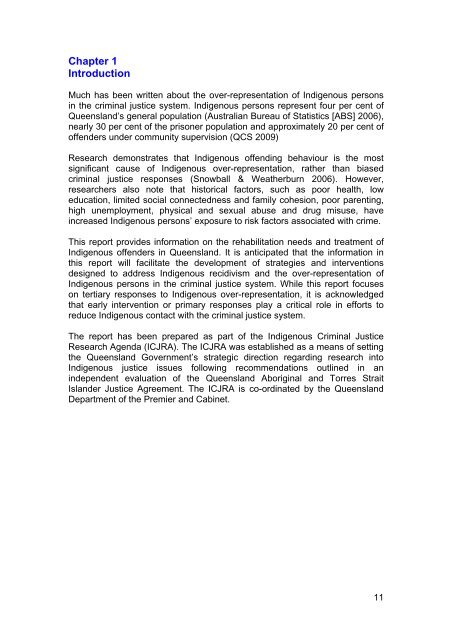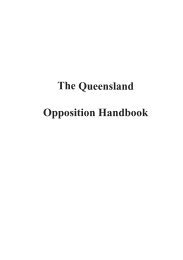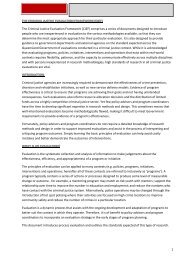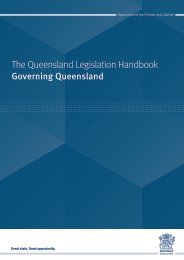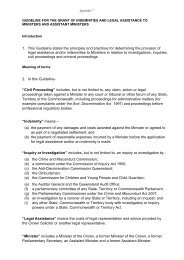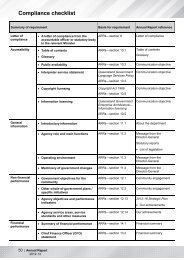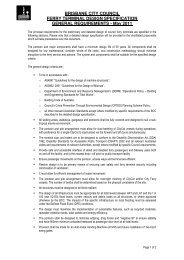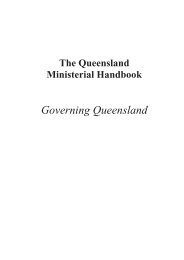Rehabilitative needs and treatment of Indigenous offenders in ...
Rehabilitative needs and treatment of Indigenous offenders in ...
Rehabilitative needs and treatment of Indigenous offenders in ...
Create successful ePaper yourself
Turn your PDF publications into a flip-book with our unique Google optimized e-Paper software.
Chapter 1IntroductionMuch has been written about the over-representation <strong>of</strong> <strong>Indigenous</strong> persons<strong>in</strong> the crim<strong>in</strong>al justice system. <strong>Indigenous</strong> persons represent four per cent <strong>of</strong>Queensl<strong>and</strong>’s general population (Australian Bureau <strong>of</strong> Statistics [ABS] 2006),nearly 30 per cent <strong>of</strong> the prisoner population <strong>and</strong> approximately 20 per cent <strong>of</strong><strong>of</strong>fenders under community supervision (QCS 2009)Research demonstrates that <strong>Indigenous</strong> <strong>of</strong>fend<strong>in</strong>g behaviour is the mostsignificant cause <strong>of</strong> <strong>Indigenous</strong> over-representation, rather than biasedcrim<strong>in</strong>al justice responses (Snowball & Weatherburn 2006). However,researchers also note that historical factors, such as poor health, loweducation, limited social connectedness <strong>and</strong> family cohesion, poor parent<strong>in</strong>g,high unemployment, physical <strong>and</strong> sexual abuse <strong>and</strong> drug misuse, have<strong>in</strong>creased <strong>Indigenous</strong> persons’ exposure to risk factors associated with crime.This report provides <strong>in</strong>formation on the rehabilitation <strong>needs</strong> <strong>and</strong> <strong>treatment</strong> <strong>of</strong><strong>Indigenous</strong> <strong>of</strong>fenders <strong>in</strong> Queensl<strong>and</strong>. It is anticipated that the <strong>in</strong>formation <strong>in</strong>this report will facilitate the development <strong>of</strong> strategies <strong>and</strong> <strong>in</strong>terventionsdesigned to address <strong>Indigenous</strong> recidivism <strong>and</strong> the over-representation <strong>of</strong><strong>Indigenous</strong> persons <strong>in</strong> the crim<strong>in</strong>al justice system. While this report focuseson tertiary responses to <strong>Indigenous</strong> over-representation, it is acknowledgedthat early <strong>in</strong>tervention or primary responses play a critical role <strong>in</strong> efforts toreduce <strong>Indigenous</strong> contact with the crim<strong>in</strong>al justice system.The report has been prepared as part <strong>of</strong> the <strong>Indigenous</strong> Crim<strong>in</strong>al JusticeResearch Agenda (ICJRA). The ICJRA was established as a means <strong>of</strong> sett<strong>in</strong>gthe Queensl<strong>and</strong> Government’s strategic direction regard<strong>in</strong>g research <strong>in</strong>to<strong>Indigenous</strong> justice issues follow<strong>in</strong>g recommendations outl<strong>in</strong>ed <strong>in</strong> an<strong>in</strong>dependent evaluation <strong>of</strong> the Queensl<strong>and</strong> Aborig<strong>in</strong>al <strong>and</strong> Torres StraitIsl<strong>and</strong>er Justice Agreement. The ICJRA is co-ord<strong>in</strong>ated by the Queensl<strong>and</strong>Department <strong>of</strong> the Premier <strong>and</strong> Cab<strong>in</strong>et.11


